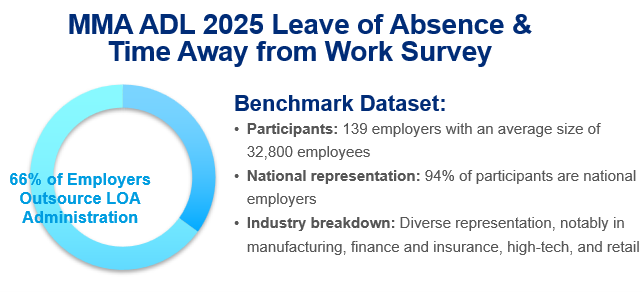To Insource or Outsource Leave of Absence Administration? There’s No Easy Way “In” or “Out”
 In the world of Leave of Absence (LOA) administration, each employer must decide whether to insource or outsource their LOA case management process. There are pros and cons for both strategies and even when outsourcing, there will be oversight. This article attempts to explore the factors an employer may consider when deciding on their LOA administration strategy.
In the world of Leave of Absence (LOA) administration, each employer must decide whether to insource or outsource their LOA case management process. There are pros and cons for both strategies and even when outsourcing, there will be oversight. This article attempts to explore the factors an employer may consider when deciding on their LOA administration strategy.
Insourcing LOA administration refers to managing these requests internally within your own organization. Typically, insourced or in-house LOA administration utilizes the employer’s own employees as part of an LOA group or team (i.e., case managers) and LOA case management software. This approach allows organizations to maintain direct control over the administration process, ensuring that policies are consistently applied and aligned with company culture. Alternatively, the outsourcing of LOA administration is exactly what it sounds like – it typically involves hiring a third-party administrator (TPA) or insurer to manage LOA administration on behalf of the organization. This option can take advantage of the TPA/insurer’s scalability, expertise, streamlined processes, and potentially reduce administrative burdens.
It can be very challenging to view LOA administration in a vacuum because it is so closely aligned with short-term disability (STD) benefits and/or statutory paid benefits (e.g., paid family and medical leave (PFML)). Each of those benefits adds a layer of complexity, because an employer may choose to have a company-funded or fully-insured STD program, and can choose to utilize a state-administered or equivalent private plan for PFML. Regardless of those decisions, it is critical for employers to coordinate all three aspects (LOA, STD, and statutory benefits) across policies, processes, and the employee experience. The decision to insource or outsource LOA administration could be a factor but is not determinative of how an employer administers STD or PFML. Any combination can work. For example, an employer in Massachusetts could administer all three internally or externally, or a combination:
- “Fully insourced” could look like: an in-house LOA program, with the same group administering a company-funded STD program along with a self-funded, equivalent private Massachusetts PFML program.
- Mixed programs could be any combination: insourced LOA, self-administered and company-funded STD, and the state administering its PFML program; OR outsourced LOA and STD (both managed by the insurer), and the state administering its PFML program.
- “Fully outsourced” would have no insourced aspects: LOA and STD outsourced to the insurer, and Massachusetts PFML, either through the state plan or an equivalent private plan, managed by the same insurer as LOA/STD.
Whether to Insource or Outsource LOA Administration
Back to the question at-hand: whether to insource or outsource LOA administration? The Marsh McLennan Agency (MMA) Absence, Disability, and Life practice recently engaged large employers to complete the biannual Time Away From Work Survey, which shows that approximately two-thirds of employers outsource their LOA administration.

With this insight into what many large employers are currently doing, we must understand why – what factors drive an employer’s decision to insource or outsource LOA administration? In many cases, the difference in cost is not significant enough to be the deciding factor. Insourced LOA comes with costs related to the employees and LOA software, while outsourced costs come from the ongoing fees owed to the TPA or insurer. However, there are many variables that might impact the cost of either option. For example, an employer might analyze the relatively comparable cost of hiring the LOA case management team versus the per-employee, per-month (PEPM) fees of outsourcing to a TPA. But when the employer engages an industry consultant, they may learn of other factors that impact costs of insourcing, such as the need to hire additional headcount beyond just the case managers (i.e., supervisors and trainers), or the HRIS/IT resources that will be needed to implement and integrate the SaaS LOA solution with other systems.
Insourcing LOA Administration
When employers choose to insource their LOA administration, they often prioritize the employee experience and aim to ensure that the LOA process is closely aligned with their company culture. Insourcing allows for greater control and customization of the LOA process, enabling employers to tailor policies and procedures to fit their organizational values. However, this control can be limited by the employer’s choice of LOA case management software, which is typically purchased as a software-as-a-service (SaaS) solution. Any choice of SaaS LOA administration software should focus on the employer’s needs, assuming that it fulfills the basic compliance requirements related to federal and state leaves (e.g., eligibility engine, notification/documentation requirements). Additionally, insourced LOA programs also have to account for non-operational (support) activities outside the scope of traditional case management. These functions include: tracking new and updated regulations for compliance, conducting quality control audits, managing escalations, and accessing specialized medical expertise, all of which are critical for maintaining an effective LOA program.
Outsourcing LOA Administration
On the other hand, outsourcing LOA administration to third-party administrators (TPAs) or insurers presents its own set of advantages and challenges. While these external providers may not fully replicate a company's unique culture in the LOA process, they bring a wealth of specialization and expertise in areas such as compliance, audits, and medical assessments. This expertise is derived from their ability to leverage resources across multiple clients, allowing them to stay updated on industry regulations and best practices. Furthermore, TPAs and insurers can offer standardized processes that enhance efficiency and consistency, which can be difficult for insourced programs to achieve. By utilizing their extensive industry knowledge, these external partners can help employers navigate complex compliance landscapes and implement best practices that improve overall LOA management. Nonetheless, we do hear stories of employers making a change and ending up underwhelmed by the service experience.
Pro tip: Having a specialized consultant who can bring rigor to the planning, implementation, and oversight tracking has proved to be helpful and effective in achieving a more successful leaves program.
The Pros and Cons of Insourcing Versus Outsourcing
The pros and cons of each option can significantly impact an employer's decision-making process. Of course, this is not a static list due to the ever-changing nature of LOA regulations, and other factors that may drastically change some aspects of LOA administration, such as the use of artificial intelligence (AI). Both employers and TPA/insurers may see changes to the LOA process with enhancements in AI showing the potential to increase efficiency of the claims management process. But for now, here are some key factors to consider for each:
|
Insourced LOA Administration |
|
|
|
|
|
|
|
Outsourced LOA Administration |
|
|
|
|
|
|
This is not an easy decision for any employer, and no single factor can dictate the best approach. Ultimately, it comes down to whether the employer wants to develop the necessary processes and expertise in-house or shift the workload elsewhere to focus more resources on other issues and projects.
Additional Considerations
For employers opting to outsource their LOA administration, it’s important to recognize that this is not a “set it and forget it” solution. While outsourcing can alleviate some administrative burdens, employers must still maintain a level of LOA expertise to effectively manage vendor relationships. This includes overseeing vendor performance, handling escalations, and providing training for internal supervisors and managers to ensure they understand the LOA process and can support their teams effectively. If an employer finds that their current LOA administration – whether insourced or outsourced – is not meeting expectations, there are several options to consider. This may include claim audits, reviewing and updating process control documents, or conducting a process review with the vendor.
For those with insourced programs, conducting an end-to-end process review can be beneficial. Engaging a consultant with expertise in the absence space can provide an objective assessment of current policies and practices, and also allow for a review of available SaaS options to increase performance or explore alternative solutions. Additionally, identifying opportunities for improvement outside of claims administration, such as compliance and quality audits, can strengthen the overall program.
A specialized absence consultant lends a fresh pair of eyes to these myriad issues and can help to increase the chances of success in whatever initiative an employer chooses. On the other hand, employers utilizing outsourced services should consider a thorough process review to identify best practices. Engaging with the current vendor to address any issues and ensure alignment with organizational goals is crucial, along with setting up an objective review of performance. If necessary, conducting a Request for Information (RFI) or Request for Proposal (RFP) can help explore alternative vendors that may better meet the organization’s needs.
Pro tip: It goes a long way if employees feel heard when it comes to issues related to leaves administration and overall experience. A simple survey can achieve this and more, enabling the employer to frame the issues, mitigate and implement solutions in a more thoughtful and holistic manner.
Regardless of the chosen model, both insourced and outsourced programs can benefit from regular policy reviews, clear employee communications, and targeted training for supervisors and managers. These steps are essential for maintaining compliance and ensuring that all stakeholders are informed and equipped to navigate the LOA process effectively.
For employers seeking assistance with any of these matters, the MMA ADL practice is always available to help and can be reached through Jim Reardon at [email protected].
Jim Jantz, Director of Compliance
Jim Reardon, Client Executive
Marsh McLennan Agency / Absence Disability and Life (MMA-ADL)

